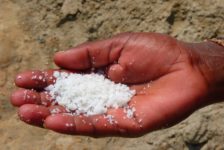
Photo courtesy WLodi, London, UK. Creative Commons.
What are they?
Crystals are solid materials with components that are arranged in ordered structures. These structures form a crystal lattice, a series of repeating units, that extends in all directions. Even though the structure is at the microscopic level, you can usually identify crystals with your eyes based on their shape and the orientation of their flat sides.
Where can I find them?
Usually in rocks as things such as quartz, diamonds and emeralds. Ice is also a crystal, so snow is a collection of crystals. You can also find crystals in living creatures, such as calcite or aragonite shells on snails or clams—even in your own body in the form of bone.
Bone’s a crystal?
Around 70 percent by weight of it is. Hydroxylapatite is composed of calcium, phosphorous, oxygen and hydrogen and makes up the mineral part of bone as well as tooth enamel. Interestingly, hydroxylapatite can exchange its oxygen-hydrogen (hydroxyl) groups for fluoride ions—negatively-charged fluorine atoms. If this happens in your teeth from drinking fluoridated water, your risk of cavities decreases.
How do crystals form?
Via two major steps: nucleation and crystal growth. Nucleation is the beginning of crystal formation, where bits of solid particles in a liquid or gas gather together in clusters. If the clusters are stable, they form an organized structure specific to that type of crystal. If the crystals are not stable (due to small size or temperature, for example) they dissolve. A stable cluster undergoes crystal growth, where it adds identical repeating units, once it has formed.
What kinds of crystal structures are there?
A lot. Crystals are defined by their symmetry, the relative lengths of the repeating unit’s edges, angles between those lengths and other factors. For example, hydroxylapatite belongs to the hexagonal crystal system, which requires a hexagonal lattice—that is, the arrangement of atoms making up the crystal look like a hexagon. The mineral beryl, which includes both aquamarines and emeralds, also belongs to this system, but it belongs to a different crystal class based on its slightly different atom arrangement.
What’s your bias?
I am neither a geologist nor an inorganic chemist, but I do like to look at shiny things, and it’s always fun to find a crystal when you’re going for a hike.









